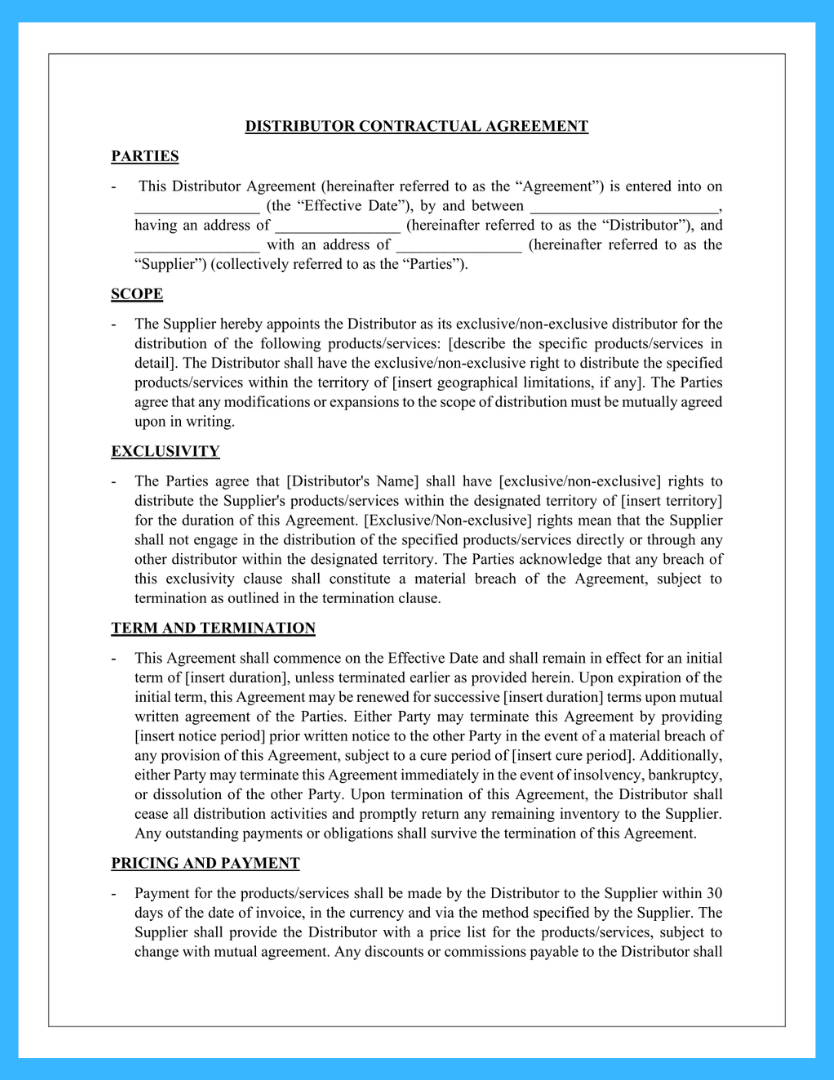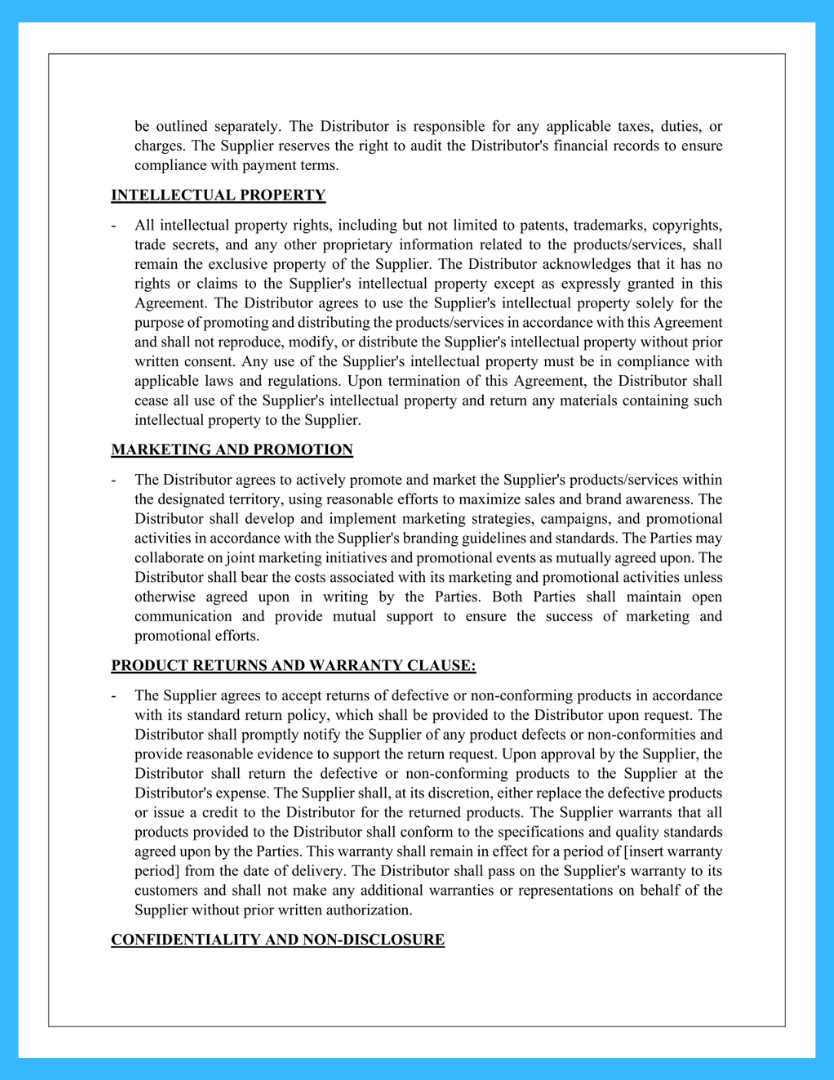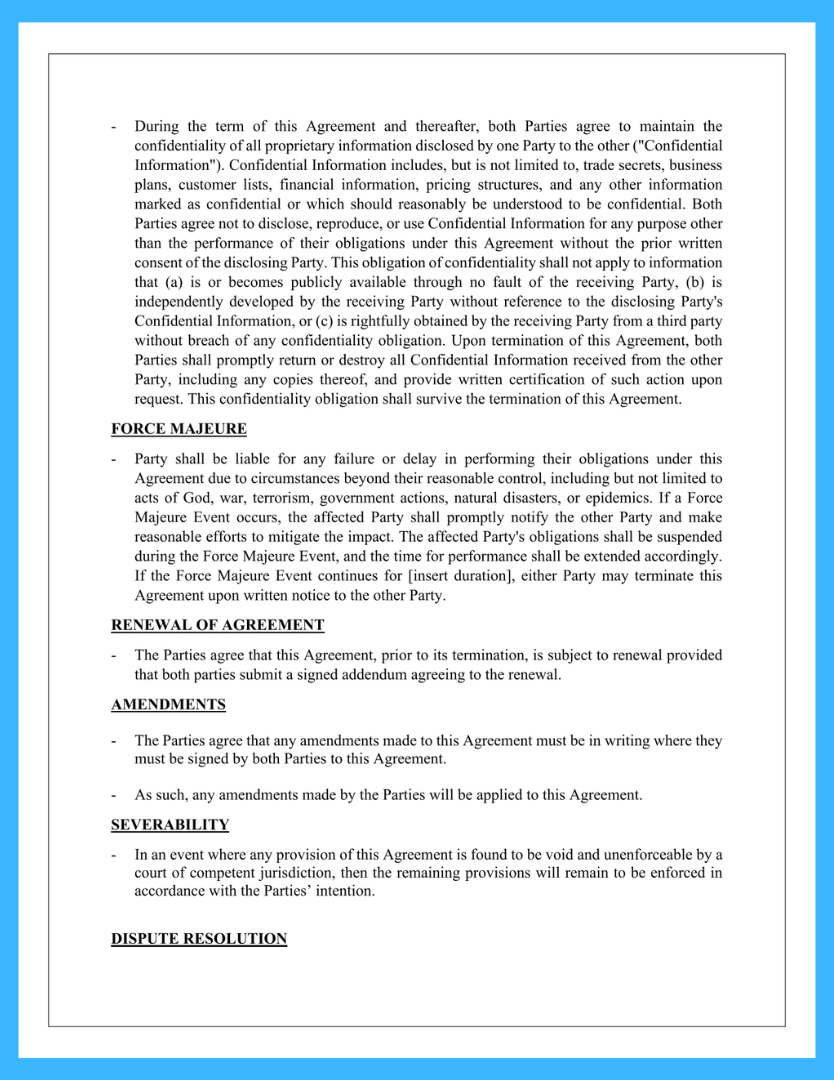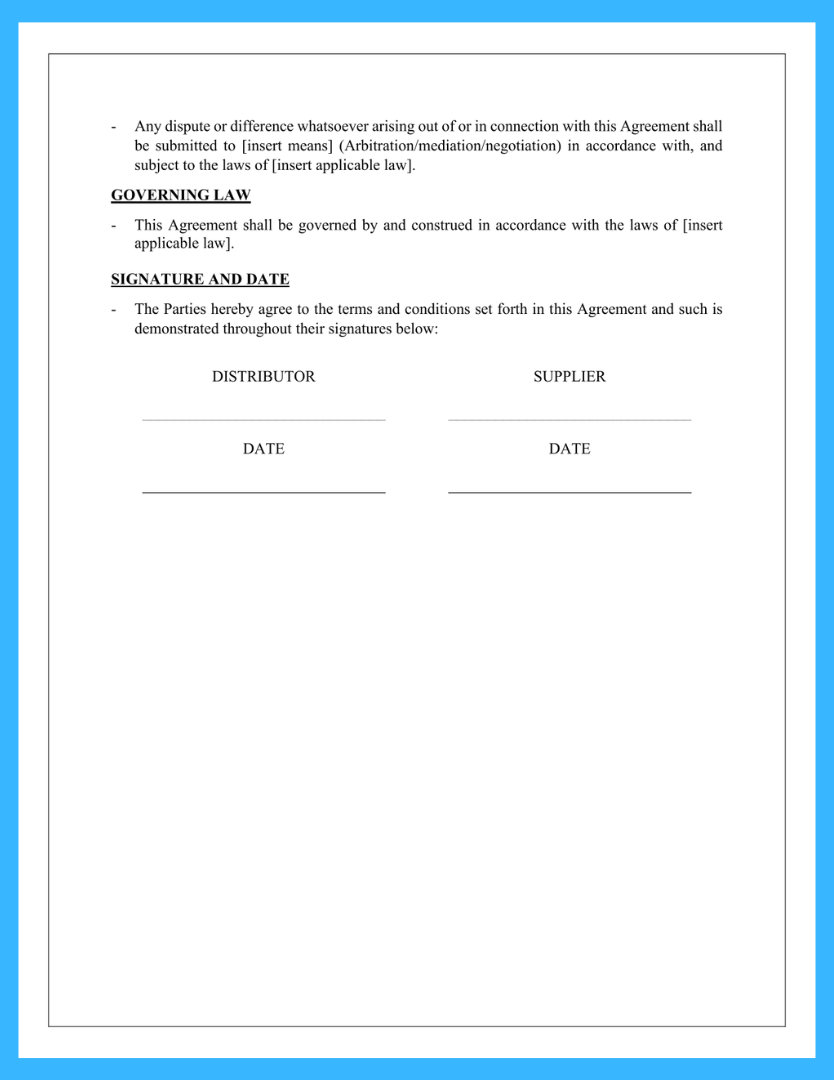
A distribution agreement outlines the terms under which a manufacturer grants a distributor the right to distribute, resell, and promote their products in a defined territory. This guide outlines best practices in creating a distribution agreement, and provides a template to kickstart your efforts.




A distribution agreement is a legally binding contract between a manufacturer or supplier (the licensor) and a distributor (the licensee) that authorizes the distributor to purchase, stock, advertise, and resell the manufacturer’s products in a specific geographical region or territory.
The agreement grants the distributor access to the supplier’s products at wholesale prices for resale purposes but does not transfer ownership of the products to the distributor.
The key parties in a distribution agreement are the licensor/supplier who manufactures or supplies the products and the licensee/distributor who purchases, stores, markets, and resells the products to customers at a markup. The agreement outlines the product details, pricing, minimum order quantities, sales territory, marketing responsibilities, quality controls, inventory levels, payment methods, confidentiality, and other terms that govern the business relationship.
Distribution agreements provide mutual benefits to both parties. The manufacturer gains new sales channels and expanded market reach without significant overhead costs. The distributor obtains products to sell for a profit margin within an assigned territory.
A distribution agreement template is useful when a manufacturer wants to authorize a third party to market, sell, and distribute their products in a defined region without taking on the operational costs and responsibilities of managing sales channels themselves.
It’s an efficient way to expand into new territories and tap into an established distributor’s customer base without additional overhead. The formal agreement outlines all expectations upfront regarding product prices, order processes, promotional activities, territory boundaries, sales metrics reporting, and other logistics.
Having a template in place makes it simple to onboard new distributors as you grow and want to enter additional markets. It also ensures consistency across all partnerships regarding terms, rights, quality controls, etc. See the complete distribution agreement template below.
The critical difference between a distribution agreement and a purchase agreement is that a distribution agreement authorizes a distributor to market and resell a supplier’s products, while a purchase agreement is for the one-time purchase of products or goods.
Under a distribution agreement, the distributor purchases inventory from the supplier at wholesale prices for resale purposes, but the supplier retains ownership of the products. The distributor acts as a channel partner to sell and promote the supplier’s offerings in an assigned territory.
Conversely, a purchase agreement is for the outright purchase of goods to become the buyer’s property. It transfers product ownership and is typically a one-off transaction, not an ongoing business relationship.
Understanding these differences is critical when establishing reseller partnerships to correctly structure expectations, rights, inventory, and compensation. Mistaking one type of agreement for the other can cause significant legal and financial issues down the road.
A comprehensive distribution agreement clearly defines all critical elements of the business relationship so both parties understand their rights and obligations. Key components to include are:
Identify the official legal names and addresses of the supplier/licensor and distributor/licensee. Define if either party has affiliates or parent companies bound by the agreement terms. Outlining detailed contact information ensures proper legal notices are delivered efficiently. Specify signatory titles like owners, presidents, etc.
Provide specifics on the supplier’s products, product lines, brands, models, etc., that the distributor can purchase and resell. Detailed descriptions eliminate confusion over which offerings the agreement covers now and in the future as new products are added. Include technical specs, features, sizes, capacities, etc. Images or attachments help.
Outline where, how, and when the distributor will provide inventory, such as direct shipping, 3PL delivery, will-call order pickup, just-in-time inventory, etc. Also, thoughtfully define clear rules regarding stocking adequate products to meet demand without excessive warehousing of goods, managing seasonal volume spikes or inventory shortages potentially causing backorder dilemmas, and contractually addressing supply chain disruptions regarding logistical or raw material issues. Articulating fulfillment processes upfront is essential for coordination.
Thoroughly define the geographical areas or market segments where the distributor maintains exclusive or non-exclusive promotional and sales distribution rights regarding the supplier’s covered products under this agreement. Carefully detailing this territorial scope ensures no conflicts occur with other authorized reseller partners already operating in the assigned region unless intentionally overlapping as indicated by explicitly defined terms.
Additionally, outline if broader ecommerce or internet sales also get permitted under this contract along with applicable usage policies around advertising channels, customer geo-mappings, web restrictions preventing cannibalizing physical resellers, etc.
Specify how the distributor will officially place routine product orders with the supplier, such as through an online B2B customer portal if available, emailed POs containing necessary data for fulfillment teams, etc. Explicitly detail expected timeframes regarding order acceptance, requested revisions if data is unclear, manufacturing/processing lead times if customization is involved, standard lead times for inventory items in stock, approved freight methods, and programs based on geographic cutoffs.
It’s also important to outline agreed-upon shipping terms if using Incoterms, including noting which party bears responsibility for insurance and formal transfer of ownership/title triggers, allowing customer acceptance while in transit.
Carefully provide the negotiated formula, bulk discount schedules, or framework for determining the exact wholesale pricing the distribution partner will prepay when positioning orders for the supplier’s covered product inventory being purchased for resale under this agreement. Pricing guides may involve formal price lists in exhibits that outline standard baseline retail costs to which preset trade discounts are applied at tiered graduated levels based on total order value thresholds achieved cumulatively over specified rolling periods.
Also, clearly outline formally approved payment methods and strict timing of when advance payments must be fully render from the distributor to the vendor to officially lock in supplied goods for fulfillment along with standard payment terms if credit gets extended, such as net 30 days after invoices get generated upon outgoing shipments.
Address mandatory product quality control standards the distribution partner must uphold and maintain regarding climate-controlled storage conditions while warehousing inventory, handling procedures used when processing orders for maximizing preservation, inspection processes before final outbound transportation, ongoing monitoring criteria regarding aged packaged stock to ensure first-expiring first-out practices, etc.
Accordingly, include periodic random inspection rights the supplier reserves along with requirements around satisfactorily addressing any inventory found damaged or rendered defective for properly upholding brand standards customers anticipate associating with the manufacturer.
Thoroughly characterize any permitted and prohibited operational activities, either contractually imposed or legally regulated, on both parties. Address aspects such as approved advertising procedures reviewed to safeguard branding guidelines compliance and guard against deceptive market practices. Outline protocols around authorized trade promotions – whether targeting end consumers to avoid channel conflicts or addressing reseller partnerships in assigned territories.
Detail usage terms and oversight governing the exploitation of trademarks, patents, and other protected intellectual property. List requirements to host educational training sessions and expectations around trade show participation. Explain proper sales reporting procedures needed for accurately tracking performance goals across regions.
Include non-disclosure provisions regarding sensitive information like pricing, customer data, intellectual property, and other trade secrets. Such provision ensures critical supplier and distributor information remains protected. Outline what confidential data can be collected, stored, accessed, processed, and shared. Define security protocols required.
Define the distribution agreement terms, such as one year, three years, etc. Outline conditions for renewal, including new negotiations. This ensures expectations are reset periodically as business needs evolve. Include timing guidelines for essential written notice like non-renewal intent, breach of contract, etc.
Address liability caps for damages, uninsured losses, intellectual property infringement, injuries, etc., caused by either party. Including reasonable limitations prevents excessive unforeseen risks. Define what constitutes a default and material breach of the agreement. Outline dispute resolution approaches like arbitration clauses (that can be aided by the American Arbitration Association).
Outline how each party can request changes to the agreement terms and approvals required with prior written consent. Allow reasonable flexibility to modify non-essential clauses over time while protecting core components. Outline specific conditions that enable early termination with sufficient notice periods. To transition smoothly, define termination implications like inventory buybacks, financial obligations, customer communication, etc..
Include standard legal clauses like entire agreement, severability, waiver, force majeure, assignability, third-party rights, notices, and governing law stipulations. This is also the section in which you define if the other party will be the exclusive distributor. These protect both parties while allowing flexibility to address unforeseen situations fairly. Define rules of interpretation and hierarchy related to conflicting agreement terms.
Once final negotiations are complete, the distribution agreement template must contain signature fields for authorized representatives from the supplier and distributor. Using e-signatures through a solution like Signaturely to sign and manage agreements digitally makes the process fast, efficient, and legally binding. Signaturely also enables sending automated reminders when it’s time to renew existing contracts.
Adding signatures finalizes the formal distribution partnership, allowing the exciting work of bringing products to market under the outlined cooperative terms to begin! With a comprehensive contract, both parties can focus on collaborating to drive brand growth rather than haggling over legal uncertainty.
We’ve got your back here at Signaturely, and we’re ready to help make stress-free contracts a reality. Forget the confusing paperwork and overwhelming legal jargon – get easy, breezy contract templates in minutes with our free template.
Click that download button now and get those wheels spinning!Signaturely provides the ideal solution for digitally creating, signing, and managing distribution agreements to establish and maintain reseller partnerships.
With Signaturely, suppliers can set up branded templates tailored to your business needs that outline all necessary legal terms, conditions, and details for your distribution contracts. Create templates for territories, products, or agreement types that can be reused and customized.
Once final negotiations are complete, Signaturely enables both parties to e-sign the agreements instantly online from anywhere, on any device—no more printing, scanning, faxing, mailing, or overnighting signature pages. The fully executed contract is automatically stored in secure Signaturely cloud storage for easy access with built-in permissions controls for sharing.
When the existing entire agreement is set to expire, Signaturely sends automatic reminders to prompt renewals or terminations. It also allows you to create schedules for any required business or compliance reviews, and maintain complete visibility into what agreements are active, expired, or coming due for each partner.
With streamlined workflows, standards, and automation, Signaturely reduces the friction, risks, and overhead costs of distribution partnerships. Intuitive features like search, tagging, activity audit trails, and reporting provide operational efficiency and insights.
Say goodbye to distribution agreement headaches! Adopt Signaturely for a complete system to establish and scale channel relationships smoothly as your business grows.
Distribution agreements are complex legal contracts that establish formal business partnerships. Here are answers to common questions:
First, identify a reputable distributor that is well-matched to sell your products. Outline mutual goals, capabilities, and benefits during initial discussions before drafting the agreement terms. Get the necessary approvals internally and externally before executing the final contract.
At a minimum, include authorized territory, product details, order/delivery procedures, inventory requirements, payment terms, sales/marketing obligations, confidentiality, liability caps, agreement duration, and signatures. Customize to your specific situation.
In return, offer compelling sales incentives like discounts, marketing assets, or exclusivity, asking for sales minimums, customer service standards, and consistent brand representation. Build periodic reviews to reset expectations.
Compromise on territories, pricing thresholds, quotas, or support responsibilities to find an arrangement that provides value for both parties based on core capabilities. Ask “what-if” to explore contingencies.
Reseller agreement, channel partner agreement, or authorized distributor agreement. The legal name depends on the specific business relationship structure.
Defining the partnership terms, rights, and responsibilities upfront is essential to avoid misunderstandings that undermine success. Take time to negotiate patiently, consult lawyers with questions, and finalize professional contracts. Using Signaturely’s robust distribution agreement template helps you get through to the finish line in your legal process, while capturing the nuances that go into complex distribution operations.